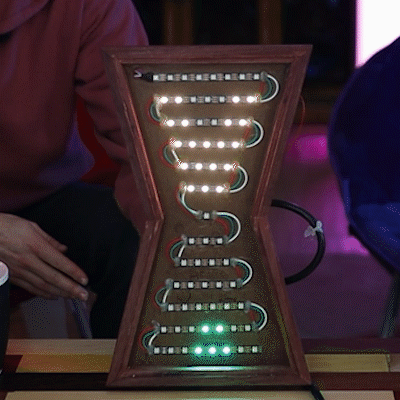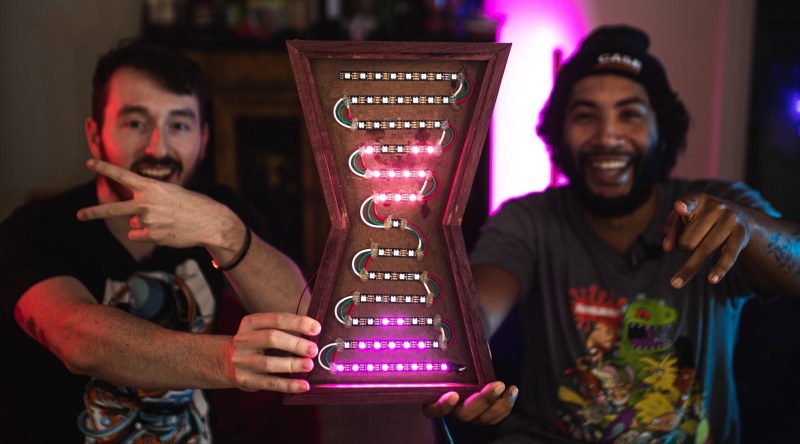If you want to waste time in a meaningful way, get yourself an hourglass. It’s simultaneously mesmerizing and terrifying to sit there and watch the seconds slip through the threshold that separates possibility from missed opportunity.
 [Ty and Gig]’s LED hourglass is equally beautiful to watch. It doesn’t actually tell time, but that’s perfectly fine by us. What it does do is animate the LEDs to approximate grains of sand in gravity, no matter how the hourglass is tilted.
[Ty and Gig]’s LED hourglass is equally beautiful to watch. It doesn’t actually tell time, but that’s perfectly fine by us. What it does do is animate the LEDs to approximate grains of sand in gravity, no matter how the hourglass is tilted.
In either vertical orientation, the sand falls as long as there is some in the top. When the hourglass is horizontal, the LEDs settle just like real sand does. [Ty and Gig] achieved this with a whole lot of code that breaks the animation frames into structure arrays.
By contrast, the hardware part of this build is fairly simple: all that’s needed to replicate this build is some RGB LEDs a beefy power supply to drive them, an accelerometer, and a microcontroller.
[Ty and Gig] were planning to use an ESP8266, but misplaced it and went with an Arduino Mega instead. (You know what they say — buy a replacement and the one you lost will turn up almost immediately.) The beautiful frame is made from leftover purpleheart, a hardwood that turns purple with exposure to air. Check out the build video after the break.
Too lazy to reset your hourglass every hour? Here’s one that flips itself.
















“buy a replacement and the one you lost will turn up almost immediately”
I usually have a “buffer” of lost objects and tools. As soon as I loose something that I often need, the previous thing I lost pops out. Usually at the precise place I had look for it several times.
I’ve come to the conclusion that in order to find something lost, I just need to loose something else on purpose.
I’m sure this phenomenon will have been fully explained in a Terry Pratchet Discworld novel. Just not sure which one!
That is probably the goddess Anoia, goddess of Things That Get Stuck In Drawers and she finds lost corkscrews and things that roll under furniture.. I’m reading Wintersmith at the moment.
She probably also has a hand in the left over screw when repairing things.
Well it’s yer basic Heisenberg innit? “The probability of finding a particle is related to the square of its wave function” Now for very small things, the probability is low, for large things the probability is high but never 100%. Therefore if you have a large enough set of things you’re trying to keep track of, some tiny percentage of them, an almost constant percentage, will not be able to have their position determined.
Wow that’s quite fancy. The general concept is a proven winner: years ago I got an “electronic sand timer” (made by Anelace) from the Tech Museum in San Jose. It’s super useful in providing a very visual representation of time remaining. Unfortunately they seem to be pretty limited production, can’t find anywhere that sells them, though Amazon used to have some: https://www.amazon.com/dp/B000KEJP6Q/. No accelerometer but still cool.
Interesting, thank you for the link!